Graphene Quantum Dot-Enabled Nanocomposites as Luminescence- and Surface-Enhanced Raman Scattering Biosensors
Abstract
1. Introduction
2. Properties of GQDs
3. Synthesis of GQDs
3.1. Top–down Approach
3.2. Bottom–up Approach
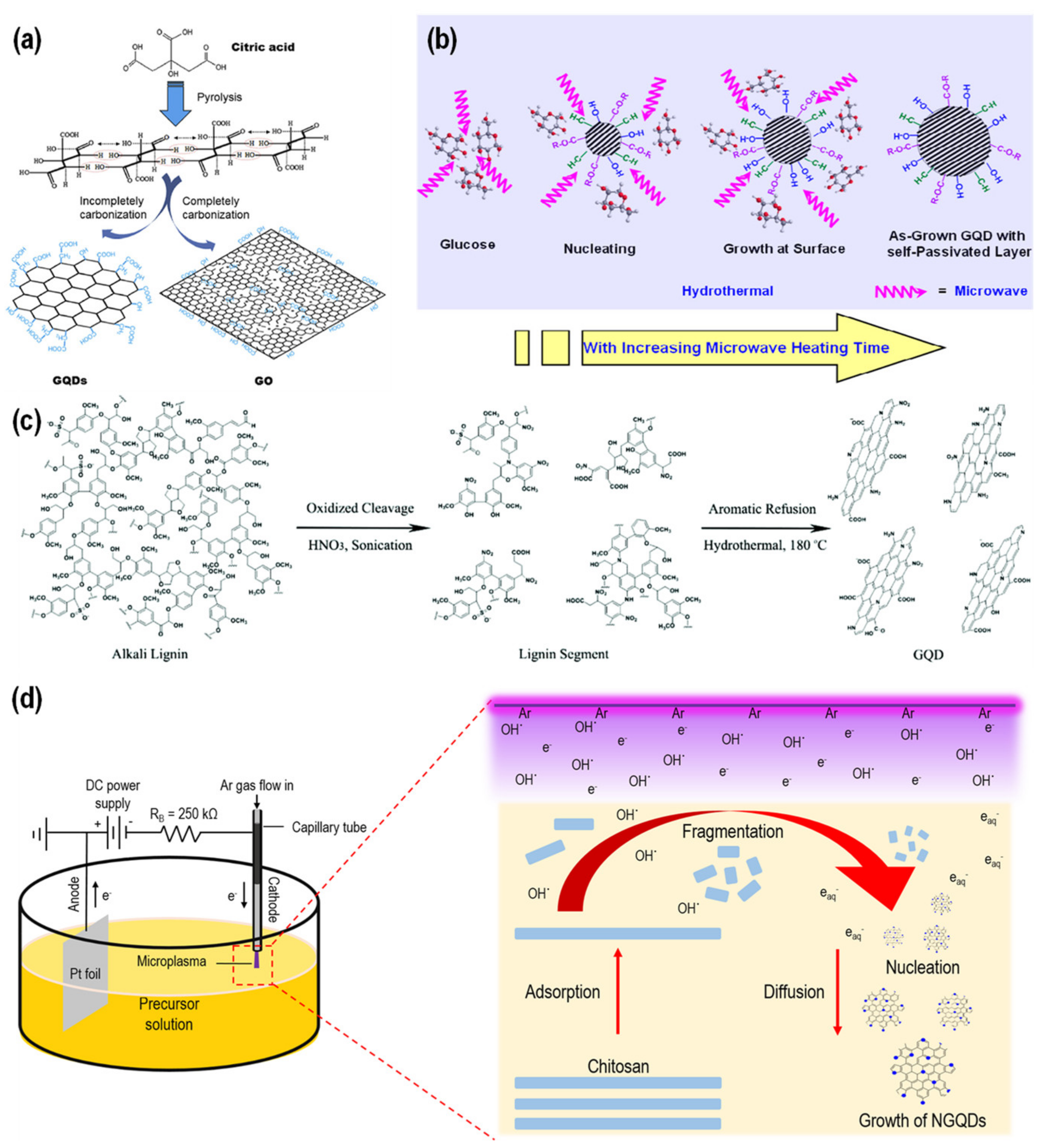
4. Fabrication of GQD Nanocomposites
4.1. GQD Nanocomposites with Organic Materials
4.2. GQD Nanocomposites with Inorganic Materials
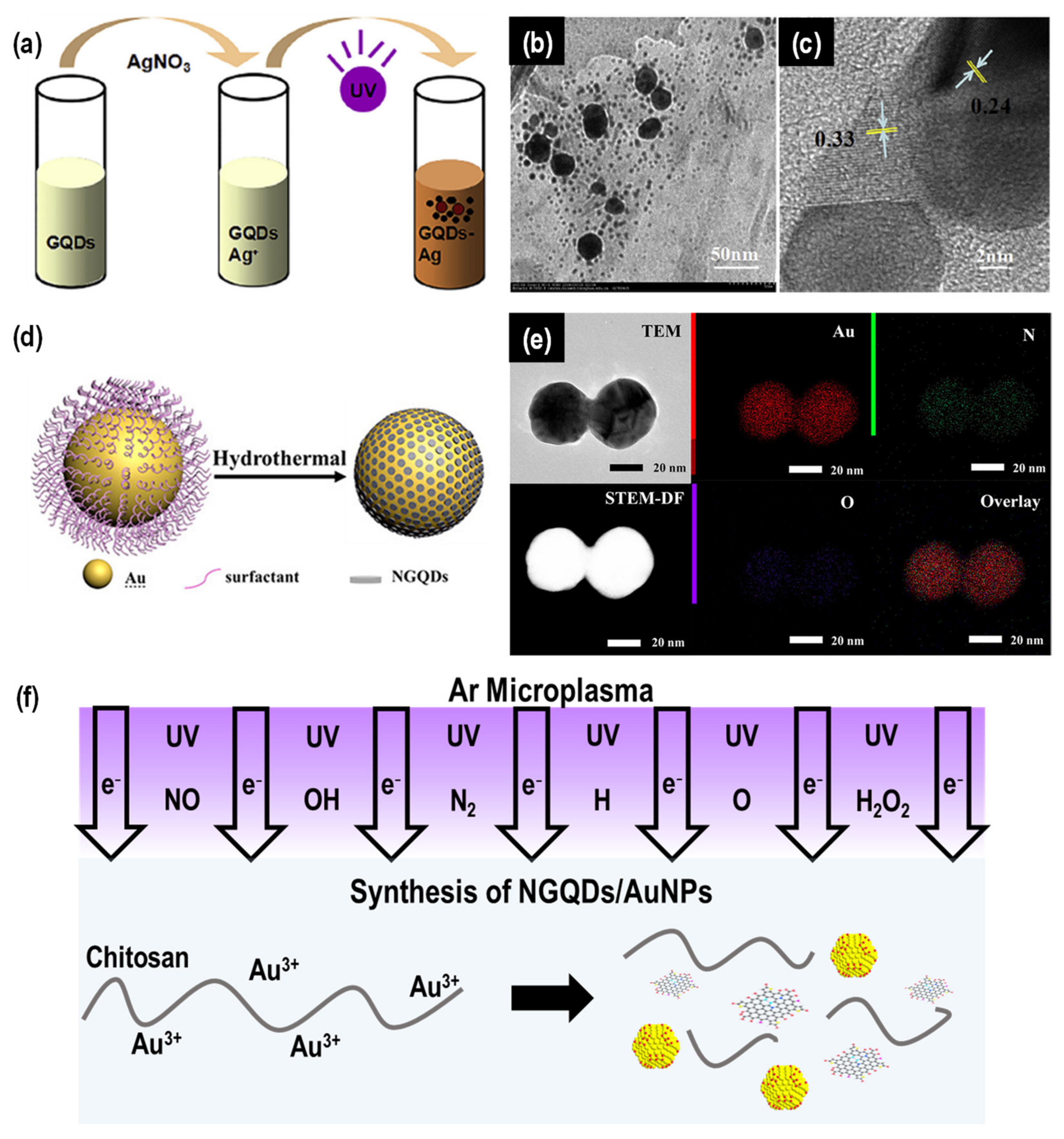
5. Luminescence-Based Biosensing Applications of GQD Nanocomposites
5.1. Photoluminescence (PL)
5.2. Chemiluminescence (CL)
5.3. Electrochemiluminescence (ECL)
6. SERS-Based Biosensing Applications of GQD Nanocomposites
7. Conclusions and Perspectives
Author Contributions
Funding
Institutional Review Board Statement
Informed Consent Statement
Data Availability Statement
Acknowledgments
Conflicts of Interest
References
- Kroto, H.W.; Heath, J.R.; O’Brien, S.C.; Curl, R.F.; Smalley, R.E. C60: Buckminsterfullerene. Nature 1985, 318, 162–163. [Google Scholar] [CrossRef]
- Iijima, S. Helical Microtubules of Graphitic Carbon. Nature 1991, 354, 56–58. [Google Scholar] [CrossRef]
- Novoselov, K.S.; Geim, A.K.; Morozov, S.V.; Jiang, D.; Zhang, Y.; Dubonos, S.V.; Grigorieva, I.V.; Firsov, A.A. Electric Field Effect in Atomically Thin Carbon Films. Science 2004, 306, 666–669. [Google Scholar] [CrossRef] [PubMed]
- Novoselov, K.S.; Jiang, Z.; Zhang, Y.; Morozov, S.V.; Stormer, H.L.; Zeitler, U.; Maan, J.C.; Boebinger, G.S.; Kim, P.; Geim, A.K. Room-Temperature Quantum Hall Effect in Graphene. Science 2007, 315, 1379. [Google Scholar] [CrossRef]
- Ponomarenko, L.A.; Schedin, F.; Katsnelson, M.I.; Yang, R.; Hill, E.W.; Novoselov, K.S.; Geim, A.K. Chaotic Dirac Billiard in Graphene Quantum Dots. Science 2008, 320, 356–358. [Google Scholar] [CrossRef]
- Pan, D.; Zhang, J.; Li, Z.; Wu, M. Hydrothermal Route for Cutting Graphene Sheets into Blue-Luminescent Graphene Quantum Dots. Adv. Mater. 2010, 22, 734–738. [Google Scholar] [CrossRef]
- Sk, M.A.; Ananthanarayanan, A.; Huang, L.; Lim, K.H.; Chen, P. Revealing the Tunable Photoluminescence Properties of Graphene Quantum Dots. J. Mater. Chem. C 2014, 2, 6954–6960. [Google Scholar] [CrossRef]
- Li, M.; Chen, T.; Gooding, J.J.; Liu, J. Review of Carbon and Graphene Quantum Dots for Sensing. ACS Sens. 2019, 4, 1732–1748. [Google Scholar] [CrossRef]
- Sohal, N.; Maity, B.; Basu, S. Recent Advances in Heteroatom-Doped Graphene Quantum Dots for Sensing Applications. RSC Adv. 2021, 11, 25586–25615. [Google Scholar] [CrossRef]
- Revesz, I.A.; Hickey, S.M.; Sweetman, M.J. Metal Ion Sensing with Graphene Quantum Dots: Detection of Harmful Contaminants and Biorelevant Species. J. Mater. Chem. B 2022, 10, 4346–4362. [Google Scholar] [CrossRef]
- Lu, H.; Li, W.; Dong, H.; Wei, M. Graphene Quantum Dots for Optical Bioimaging. Small 2019, 15, e1902136. [Google Scholar] [CrossRef] [PubMed]
- Chung, S.; Revia, R.A.; Zhang, M. Graphene Quantum Dots and Their Applications in Bioimaging, Biosensing, and Therapy. Adv. Mater. 2021, 33, e1904362. [Google Scholar] [CrossRef] [PubMed]
- Khodadadei, F.; Safarian, S.; Ghanbari, N. Methotrexate-Loaded Nitrogen-Doped Graphene Quantum Dots Nanocarriers as an Efficient Anticancer Drug Delivery System. Mater. Sci. Eng. C 2017, 79, 280–285. [Google Scholar] [CrossRef] [PubMed]
- Cheng, C.; Liang, Q.; Yan, M.; Liu, Z.; He, Q.; Wu, T.; Luo, S.; Pan, Y.; Zhao, C.; Liu, Y. Advances in Preparation, Mechanism and Applications of Graphene Quantum Dots/Semiconductor Composite Photocatalysts: A Review. J. Hazard. Mater. 2022, 424 Pt D, 127721. [Google Scholar] [CrossRef]
- Son, D.I.; Kwon, B.W.; Park, D.H.; Seo, W.S.; Yi, Y.; Angadi, B.; Lee, C.-L.; Choi, W.K. Emissive ZnO-Graphene Quantum Dots for White-Light-Emitting Diodes. Nat. Nanotechnol. 2012, 7, 465–471. [Google Scholar] [CrossRef] [PubMed]
- Li, X.; Rui, M.; Song, J.; Shen, Z.; Zeng, H. Carbon and Graphene Quantum Dots for Optoelectronic and Energy Devices: A Review. Adv. Funct. Mater. 2015, 25, 4929–4947. [Google Scholar] [CrossRef]
- Kim, D.H.; Kim, T.W. Ultrahigh Current Efficiency of Light-Emitting Devices Based on Octadecylamine-Graphene Quantum Dots. Nano Energy 2017, 32, 441–447. [Google Scholar] [CrossRef]
- Ghosh, D.; Sarkar, K.; Devi, P.; Kim, K.-H.; Kumar, P. Current and Future Perspectives of Carbon and Graphene Quantum Dots: From Synthesis to Strategy for Building Optoelectronic and Energy Devices. Renew. Sustain. Energy Rev. 2021, 135, 110391. [Google Scholar] [CrossRef]
- Tsai, H.; Shrestha, S.; Vilá, R.A.; Huang, W.; Liu, C.; Hou, C.-H.; Huang, H.-H.; Wen, X.; Li, M.; Wiederrecht, G.; et al. Bright and Stable Light-Emitting Diodes Made with Perovskite Nanocrystals Stabilized in Metal–Organic Frameworks. Nat. Photon. 2021, 15, 843–849. [Google Scholar] [CrossRef]
- Ren, X.; Zhang, X.; Xie, H.; Cai, J.; Wang, C.; Chen, E.; Xu, S.; Ye, Y.; Sun, J.; Yan, Q.; et al. Perovskite Quantum Dots for Emerging Displays: Recent Progress and Perspectives. Nanomaterials 2022, 12, 2243. [Google Scholar] [CrossRef]
- Thoniyot, P.; Tan, M.J.; Karim, A.A.; Young, D.J.; Loh, X.J. Nanoparticle-Hydrogel Composites: Concept, Design, and Applications of These Promising, Multi-Functional Materials. Adv. Sci. 2015, 2, 1400010. [Google Scholar] [CrossRef] [PubMed]
- Wang, J.; Koo, K.M.; Wang, Y.; Trau, M. Engineering State-of-the-Art Plasmonic Nanomaterials for SERS-Based Clinical Liquid Biopsy Applications. Adv. Sci. 2019, 6, 1900730. [Google Scholar] [CrossRef] [PubMed]
- Yan, Y.; Gong, J.; Chen, J.; Zeng, Z.; Huang, W.; Pu, K.; Liu, J.; Chen, P. Recent Advances on Graphene Quantum Dots: From Chemistry and Physics to Applications. Adv. Mater. 2019, 31, e1808283. [Google Scholar] [CrossRef] [PubMed]
- Li, L.; Wu, G.; Yang, G.; Peng, J.; Zhao, J.; Zhu, J.-J. Focusing on Luminescent Graphene Quantum Dots: Current Status and Future Perspectives. Nanoscale 2013, 5, 4015–4039. [Google Scholar] [CrossRef]
- Zheng, X.T.; Ananthanarayanan, A.; Luo, K.Q.; Chen, P. Glowing Graphene Quantum Dots and Carbon Dots: Properties, Syntheses, and Biological Applications. Small 2015, 11, 1620–1636. [Google Scholar] [CrossRef]
- Xu, Q.; Zhou, Q.; Hua, Z.; Xue, Q.; Zhang, C.; Wang, X.; Pan, D.; Xiao, M. Single-Particle Spectroscopic Measurements of Fluorescent Graphene Quantum Dots. ACS Nano 2013, 7, 10654–10661. [Google Scholar] [CrossRef]
- Kim, S.; Hwang, S.W.; Kim, M.-K.; Shin, D.Y.; Shin, D.H.; Kim, C.O.; Yang, S.B.; Park, J.H.; Hwang, E.; Choi, S.-H.; et al. Anomalous Behaviors of Visible Luminescence from Graphene Quantum Dots: Interplay between Size and Shape. ACS Nano 2012, 6, 8203–8208. [Google Scholar] [CrossRef]
- Jin, S.H.; Kim, D.H.; Jun, G.H.; Hong, S.H.; Jeon, S. Tuning the Photoluminescence of Graphene Quantum Dots through the Charge Transfer Effect of Functional Groups. ACS Nano 2013, 7, 1239–1245. [Google Scholar] [CrossRef]
- Dai, Y.; Long, H.; Wang, X.; Wang, Y.; Gu, Q.; Jiang, W.; Wang, Y.; Li, C.; Zeng, T.H.; Sun, Y.; et al. Versatile Graphene Quantum Dots with Tunable Nitrogen Doping. Part. Part. Syst. Charact. 2014, 31, 597–604. [Google Scholar] [CrossRef]
- Ju, J.; Chen, W. Synthesis of Highly Fluorescent Nitrogen-Doped Graphene Quantum Dots for Sensitive, Label-Free Detection of Fe (III) in Aqueous Media. Biosens. Bioelectron. 2014, 58, 219–225. [Google Scholar] [CrossRef]
- Kurniawan, D.; Chiang, W.-H. Microplasma-Enabled Colloidal Nitrogen-Doped Graphene Quantum Dots for Broad-Range Fluorescent pH Sensors. Carbon 2020, 167, 675–684. [Google Scholar] [CrossRef]
- Zhu, C.; Yang, S.; Wang, G.; Mo, R.; He, P.; Sun, J.; Di, Z.; Yuan, N.; Ding, J.; Ding, G.; et al. Negative Induction Effect of Graphite N on Graphene Quantum Dots: Tunable Band Gap Photoluminescence. J. Mater. Chem. C 2015, 3, 8810–8816. [Google Scholar] [CrossRef]
- Noor, N.F.M.; Badri, M.A.S.; Salleh, M.M.; Umar, A.A. Synthesis of White Fluorescent Pyrrolic Nitrogen-Doped Graphene Quantum Dots. Opt. Mater. 2018, 83, 306–314. [Google Scholar] [CrossRef]
- Yeh, T.-F.; Teng, C.-Y.; Chen, S.-J.; Teng, H. Nitrogen-Doped Graphene Oxide Quantum Dots as Photocatalysts for Overall Water-Splitting under Visible Light Illumination. Adv. Mater. 2014, 26, 3297–3303. [Google Scholar] [CrossRef] [PubMed]
- Du, Y.; Guo, S. Chemically Doped Fluorescent Carbon and Graphene Quantum Dots for Bioimaging, Sensor, Catalytic and Photoelectronic Applications. Nanoscale 2016, 8, 2532–2543. [Google Scholar] [CrossRef] [PubMed]
- Park, Y.; Yoo, J.; Lim, B.; Kwon, W.; Rhee, S.-W. Improving the Functionality of Carbon Nanodots: Doping and Surface Functionalization. J. Mater. Chem. A 2016, 4, 11582–11603. [Google Scholar] [CrossRef]
- Chong, Y.; Ma, Y.; Shen, H.; Tu, X.; Zhou, X.; Xu, J.; Dai, J.; Fan, S.; Zhang, Z. The In Vitro and In Vivo Toxicity of Graphene Quantum Dots. Biomaterials 2014, 35, 5041–5048. [Google Scholar] [CrossRef]
- Shang, W.; Zhang, X.; Zhang, M.; Fan, Z.; Sun, Y.; Han, M.; Fan, L. The Uptake Mechanism and Biocompatibility of Graphene Quantum Dots with Human Neural Stem Cells. Nanoscale 2014, 6, 5799–5806. [Google Scholar] [CrossRef]
- Wang, S.; Cole, I.S.; Li, Q. The Toxicity of Graphene Quantum Dots. RSC Adv. 2016, 6, 89867–89878. [Google Scholar] [CrossRef]
- Henna, T.K.; Pramod, K. Graphene Quantum Dots Redefine Nanobiomedicine. Mater. Sci. Eng. C Mater. Biol. Appl. 2020, 110, 110651. [Google Scholar] [CrossRef]
- Liang, L.; Peng, X.; Sun, F.; Kong, Z.; Shen, J.-W. A Review on the Cytotoxicity of Graphene Quantum Dots: From Experiment to Simulation. Nanoscale Adv. 2021, 3, 904–917. [Google Scholar] [CrossRef] [PubMed]
- Ye, R.; Xiang, C.; Lin, J.; Peng, Z.; Huang, K.; Yan, Z.; Cook, N.P.; Samuel, E.L.; Hwang, C.-C.; Ruan, G.; et al. Coal as an Abundant Source of Graphene Quantum Dots. Nat. Commun. 2013, 4, 2943. [Google Scholar] [CrossRef] [PubMed]
- Zhang, Y.; Li, K.; Ren, S.; Dang, Y.; Liu, G.; Zhang, R.; Zhang, K.; Long, X.; Jia, K. Coal-Derived Graphene Quantum Dots Produced by Ultrasonic Physical Tailoring and Their Capacity for Cu(II) Detection. ACS Sustain. Chem. Eng. 2019, 7, 9793–9799. [Google Scholar] [CrossRef]
- He, M.; Guo, X.; Huang, J.; Shen, H.; Zeng, Q.; Wang, L. Mass Production of Tunable Multicolor Graphene Quantum Dots from an Energy Resource of Coke By a One-Step Electrochemical Exfoliation. Carbon 2018, 140, 508–520. [Google Scholar] [CrossRef]
- Liu, B.; Xie, J.; Ma, H.; Zhang, X.; Pan, Y.; Lv, J.; Ge, H.; Ren, N.; Su, H.; Xie, X.; et al. From Graphite to Graphene Oxide and Graphene Oxide Quantum Dots. Small 2017, 13, 1601001. [Google Scholar] [CrossRef]
- Shinde, D.B.; Pillai, V.K. Electrochemical Preparation of Luminescent Graphene Quantum Dots from Multiwalled Carbon Nanotubes. Chem. Eur. J. 2012, 18, 12522–12528. [Google Scholar] [CrossRef]
- Shin, Y.; Park, J.; Hyun, D.; Yang, J.; Lee, J.-H.; Kim, J.-H.; Lee, H. Acid-Free and Oxone Oxidant-Assisted Solvothermal Synthesis of Graphene Quantum Dots Using Various Natural Carbon Materials as Resources. Nanoscale 2015, 7, 5633–5637. [Google Scholar] [CrossRef]
- Peng, J.; Gao, W.; Gupta, B.K.; Liu, Z.; Romero-Aburto, R.; Ge, L.; Song, L.; Alemany, L.B.; Zhan, X.; Gao, G.; et al. Graphene Quantum Dots Derived from Carbon Fibers. Nano Lett. 2012, 12, 844–849. [Google Scholar] [CrossRef]
- Wang, L.; Wang, Y.; Xu, T.; Liao, H.; Yao, C.; Liu, Y.; Li, Z.; Chen, Z.; Pan, D.; Sun, L.; et al. Gram-Scale Synthesis of Single-Crystalline Graphene Quantum Dots with Superior Optical Properties. Nat. Commun. 2014, 5, 5357. [Google Scholar] [CrossRef]
- Shen, C.; Ge, S.; Pang, Y.; Xi, F.; Liu, J.; Dong, X.; Chen, P. Facile and Scalable Preparation of Highly Luminescent N,S Co-Doped Graphene Quantum Dots and Their Application for Parallel Detection of Multiple Metal Ions. J. Mater. Chem. B 2017, 5, 6593–6600. [Google Scholar] [CrossRef]
- Abbas, A.; Mariana, L.T.; Phan, A.N. Biomass-Waste Derived Graphene Quantum Dots and Their Applications. Carbon 2018, 140, 77–99. [Google Scholar] [CrossRef]
- Dong, Y.; Shao, J.; Chen, C.; Li, H.; Wang, R.; Chi, Y.; Lin, X.; Chen, G. Blue Luminescent Graphene Quantum Dots and Graphene Oxide Prepared By Tuning the Carbonization Degree of Citric Acid. Carbon 2012, 50, 4738–4743. [Google Scholar] [CrossRef]
- Tang, L.; Ji, R.; Cao, X.; Lin, J.; Jiang, H.; Li, X.; Teng, K.S.; Luk, C.M.; Zeng, S.; Hao, J.; et al. Deep Ultraviolet Photoluminescence of Water-Soluble Self-Passivated Graphene Quantum Dots. ACS Nano 2012, 6, 5102–5110. [Google Scholar] [CrossRef] [PubMed]
- Ding, Z.; Li, F.; Wen, J.; Wang, X.; Sun, R. Gram-Scale Synthesis of Single-Crystalline Graphene Quantum Dots Derived from Lignin Biomass. Green Chem. 2018, 20, 1383–1390. [Google Scholar] [CrossRef]
- Kumar, S.; Aziz, S.K.T.; Girshevitz, O.; Nessim, G.D. One-Step Synthesis of N-Doped Graphene Quantum Dots from Chitosan as a Sole Precursor Using Chemical Vapor Deposition. J. Phys. Chem. C 2018, 122, 2343–2349. [Google Scholar] [CrossRef]
- Sankaran, R.M.; Giapis, K.P. Hollow Cathode Sustained Plasma Microjets: Characterization and Application to Diamond Deposition. J. Appl. Phys. 2002, 92, 2406–2411. [Google Scholar] [CrossRef]
- Kurniawan, D.; Weng, R.-J.; Setiawan, O.; Ostrikov, K.K.; Chiang, W.-H. Microplasma Nanoengineering of Emission-Tuneable Colloidal Nitrogen-Doped Graphene Quantum Dots as Smart Environmental-Responsive Nanosensors and Nanothermometers. Carbon 2021, 185, 501–513. [Google Scholar] [CrossRef]
- Lu, Y.; Xu, S.F.; Zhong, X.X.; Ostrikov, K.; Cvelbar, U.; Mariotti, D. Characterization of a DC-Driven Microplasma between a Capillary Tube and Water Surface. EPL 2013, 102, 15002. [Google Scholar] [CrossRef][Green Version]
- Bruggeman, P.J.; Kushner, M.J.; Locke, B.R.; Gardeniers, J.G.E.; Graham, W.G.; Graves, D.B.; Hofman-Caris, R.C.H.M.; Maric, D.; Reid, J.P.; Ceriani, E.; et al. Plasma–Liquid Interactions: A Review and Roadmap. Plasma Sources Sci. Technol. 2016, 25, 053002. [Google Scholar] [CrossRef]
- Zhou, R.; Zhou, R.; Prasad, K.; Fang, Z.; Speight, R.; Bazaka, K.; Ostrikov, K.K. Cold Atmospheric Plasma Activated Water as a Prospective Disinfectant: The Crucial Role of Peroxynitrite. Green Chem. 2018, 20, 5276–5284. [Google Scholar] [CrossRef]
- Park, S.; Park, J.Y.; Choe, W. Origin of Hydroxyl Radicals in a Weakly Ionized Plasma-Facing Liquid. Chem. Eng. J. 2019, 378, 122163. [Google Scholar] [CrossRef]
- Wang, Z.; Lu, Y.; Yuan, H.; Ren, Z.; Xu, C.; Chen, J. Microplasma-Assisted Rapid Synthesis of Luminescent Nitrogen-Doped Carbon Dots and Their Application in pH Sensing and Uranium Detection. Nanoscale 2015, 7, 20743–20748. [Google Scholar] [CrossRef] [PubMed]
- Chiang, W.-H.; Richmonds, C.; Sankaran, R.M. Continuous-Flow, Atmospheric-Pressure Microplasmas: A Versatile Source for Metal Nanoparticle Synthesis in the Gas or Liquid Phase. Plasma Sources Sci. Technol. 2010, 19, 034011. [Google Scholar] [CrossRef]
- Weerasinghe, J.; Scott, J.; Deshan, A.D.K.; Chen, D.; Singh, A.; Sen, S.; Sonar, P.; Vasilev, K.; Li, Q.; Ostrikov, K.K. Monochromatic Blue and Switchable Blue-Green Carbon Quantum Dots by Room-Temperature Air Plasma Processing. Adv. Mater. Technol. 2021, 7, 2100586. [Google Scholar] [CrossRef]
- Chang, G.-Y.; Kurniawan, D.; Chang, Y.-J.; Chiang, W.-H. Microplasma-Enabled Surfaced-Functionalized Silicon Quantum Dots for Label-Free Detection of Dopamine. ACS Omega 2022, 7, 223–229. [Google Scholar] [CrossRef]
- Kurniawan, D.; Jhang, R.-C.; Ostrikov, K.K.; Chiang, W.-H. Microplasma-Tunable Graphene Quantum Dots for Ultrasensitive and Selective Detection of Cancer and Neurotransmitter Biomarkers. ACS Appl. Mater. Interfaces 2021, 13, 34572–34583. [Google Scholar] [CrossRef]
- Kurniawan, D.; Anjali, B.A.; Setiawan, O.; Ostrikov, K.K.; Chung, Y.G.; Chiang, W.-H. Microplasma Band Structure Engineering in Graphene Quantum Dots for Sensitive and Wide-Range pH Sensing. ACS Appl. Mater. Interfaces 2022, 14, 1670–1683. [Google Scholar] [CrossRef]
- Yeh, P.-C.; Yoon, S.; Kurniawan, D.; Chung, Y.G.; Chiang, W.-H. Unraveling the Fluorescence Quenching of Colloidal Graphene Quantum Dots for Selective Metal Ion Detection. ACS Appl. Nano Mater. 2021, 4, 5636–5642. [Google Scholar] [CrossRef]
- Kurniawan, D.; Sharma, N.; Rahardja, M.R.; Cheng, Y.-Y.; Chen, Y.-T.; Wu, G.-X.; Yeh, Y.-Y.; Yeh, P.-C.; Ostrikov, K.K.; Chiang, W.-H. Plasma Nanoengineering of Bioresource-Derived Graphene Quantum Dots as Ultrasensitive Environmental Nanoprobes. ACS Appl. Mater. Interfaces 2022. [Google Scholar] [CrossRef]
- Yang, J.-S.; Pai, D.Z.; Chiang, W.-H. Microplasma-Enhanced Synthesis of Colloidal Graphene Quantum Dots at Ambient Conditions. Carbon 2019, 153, 315–319. [Google Scholar] [CrossRef]
- Orriere, T.; Kurniawan, D.; Chang, Y.-C.; Pai, D.Z.; Chiang, W.-H. Effect of Plasma Polarity on the Synthesis of Graphene Quantum Dots by Atmospheric-Pressure Microplasmas. Nanotechnology 2020, 31, 485001. [Google Scholar] [CrossRef] [PubMed]
- Sun, P.P.; Araud, E.M.; Huang, C.; Shen, Y.; Monroy, G.L.; Zhong, S.; Tong, Z.; Boppart, S.A.; Eden, J.G.; Nguyen, T.H. Disintegration of Simulated Drinking Water Biofilms with Arrays of Microchannel Plasma Jets. NPJ Biofilms Microbiomes 2018, 4, 24. [Google Scholar] [CrossRef] [PubMed]
- Chiang, W.-H.; Mariotti, D.; Sankaran, R.M.; Eden, J.G.; Ostrikov, K.K. Microplasmas for Advanced Materials and Devices. Adv. Mater. 2020, 32, e1905508. [Google Scholar] [CrossRef] [PubMed]
- Lin, L.; Pho, H.Q.; Zong, L.; Li, S.; Pourali, N.; Rebrov, E.; Tran, N.N.; Ostrikov, K.K.; Hessel, V. Microfluidic Plasmas: Novel Technique for Chemistry and Chemical Engineering. Chem. Eng. J. 2021, 417, 129355. [Google Scholar] [CrossRef]
- Mousavi, S.M.; Hashemi, S.A.; Kalashgrani, M.Y.; Omidifar, N.; Bahrani, S.; Rao, N.V.; Babapoor, A.; Gholami, A.; Chiang, W.-H. Bioactive Graphene Quantum Dots Based Polymer Composite for Biomedical Applications. Polymers 2022, 14, 617. [Google Scholar] [CrossRef]
- Kovalchuk, A.; Huang, K.; Xiang, C.; Marti, A.A.; Tour, J.M. Luminescent Polymer Composite Films Containing Coal-Derived Graphene Quantum Dots. ACS Appl. Mater. Interfaces 2015, 7, 26063–26068. [Google Scholar] [CrossRef]
- Chen, Y.-X.; Lu, D.; Wang, G.-G.; Huangfu, J.; Wu, Q.-B.; Wang, X.-F.; Liu, L.-F.; Ye, D.-M.; Yan, B.; Han, J. Highly Efficient Orange Emissive Graphene Quantum Dots Prepared by Acid-Free Method for White LEDs. ACS Sustain. Chem. Eng. 2020, 8, 6657–6666. [Google Scholar] [CrossRef]
- Nair, R.V.; Thomas, R.T.; Mohamed, A.P.; Pillai, S. Fluorescent Turn-Off Sensor Based on Sulphur-Doped Graphene Quantum Dots in Colloidal and Film Forms for the Ultrasensitive Detection of Carbamate Pesticides. Microchem. J. 2020, 157, 104971. [Google Scholar] [CrossRef]
- Liu, M. Optical Properties of Carbon Dots: A Review. Nanoarchitectonics 2019, 1, 1–12. [Google Scholar] [CrossRef]
- Laysandra, L.; Chuang, C.-H.; Kobayashi, S.; Au-Duong, A.-N.; Cheng, Y.-H.; Li, Y.-T.; Mburu, M.M.; Isono, T.; Satoh, T.; Chiu, Y.-C. Design of Self-Cross-Linkable Poly(n-butyl acrylate)-co-poly[N-(hydroxymethyl)acrylamide] Amphiphilic Copolymers toward Elastic and Self-Healing Properties. ACS Appl. Polym. Mater. 2020, 2, 5432–5443. [Google Scholar] [CrossRef]
- Laysandra, L.; Kurniawan, D.; Wang, C.-L.; Chiang, W.-H.; Chiu, Y.-C. Synergistic Effect in a Graphene Quantum Dot-Enabled Luminescent Skinlike Copolymer for Long-Term pH Detection. ACS Appl. Mater. Interfaces 2021, 13, 60413–60424. [Google Scholar] [CrossRef] [PubMed]
- Li, Y.; Hu, Y.; Zhao, Y.; Shi, G.; Deng, L.; Hou, Y.; Qu, L. An Electrochemical Avenue to Green-Luminescent Graphene Quantum Dots as Potential Electron-Acceptors for Photovoltaics. Adv. Mater. 2011, 23, 776–780. [Google Scholar] [CrossRef] [PubMed]
- Ge, J.; Li, Y.; Wang, J.; Pu, Y.; Xue, W.; Liu, X. Green Synthesis of Graphene Quantum Dots and Silver Nanoparticles Compounds with Excellent Surface Enhanced Raman Scattering Performance. J. Alloys Compd. 2016, 663, 166–171. [Google Scholar] [CrossRef]
- Jin, J.; Song, W.; Wang, J.; Li, L.; Tian, Y.; Zhu, S.; Zhang, Y.; Xu, S.; Yang, B.; Zhao, B. A Highly Sensitive SERS Platform Based on Small-Sized Ag/GQDs Nanozyme for Intracellular Analysis. Chem. Eng. J. 2022, 430, 132687. [Google Scholar] [CrossRef]
- Miao, X.; Wen, S.; Su, Y.; Fu, J.; Luo, X.; Wu, P.; Cai, C.; Jelinek, R.; Jiang, L.-P.; Zhu, J.-J. Graphene Quantum Dots Wrapped Gold Nanoparticles with Integrated Enhancement Mechanisms as Sensitive and Homogeneous Substrates for Surface-Enhanced Raman Spectroscopy. Anal. Chem. 2019, 91, 7295–7303. [Google Scholar] [CrossRef] [PubMed]
- Das, R.; Paul, K.K.; Giri, P.K. Highly Sensitive and Selective Label-Free Detection of Dopamine in Human Serum Based on Nitrogen-Doped Graphene Quantum Dots Decorated on Au Nanoparticles: Mechanistic Insights Through Microscopic and Spectroscopic Studies. Appl. Surf. Sci. 2019, 490, 318–330. [Google Scholar] [CrossRef]
- Kurniawan, D.; Rahardja, M.R.; Fedotov, P.V.; Obraztsova, E.D.; Ostrikov, K.K.; Chiang, W.-H. Plasma-Bioresource-Derived Multifunctional Porous NGQD/AuNP Nanocomposites for Water Monitoring and Purification. Chem. Eng. J. 2023, 451, 139083. [Google Scholar] [CrossRef]
- Thakur, M.K.; Fang, C.-Y.; Yang, Y.-T.; Effendi, T.A.; Roy, P.K.; Chen, R.-S.; Ostrikov, K.K.; Chiang, W.-H.; Chattopadhyay, S. Microplasma-Enabled Graphene Quantum Dot-Wrapped Gold Nanoparticles with Synergistic Enhancement for Broad Band Photodetection. ACS Appl. Mater. Interfaces 2020, 12, 28550–28560. [Google Scholar] [CrossRef]
- Wang, J.; Gao, X.; Sun, H.; Su, B.; Gao, C. Monodispersed Graphene Quantum Dots Encapsulated Ag Nanoparticles for Surface-Enhanced Raman Scattering. Mater. Lett. 2016, 162, 142–145. [Google Scholar] [CrossRef]
- Liu, J.; Qin, L.; Kang, S.-Z.; Li, G.; Li, X. Gold Nanoparticles/Glycine Derivatives/Graphene Quantum Dots Composite with Tunable Fluorescence and Surface Enhanced Raman Scattering Signals for Cellular Imaging. Mater. Des. 2017, 123, 32–38. [Google Scholar] [CrossRef]
- Sun, J.; Cui, F.; Zhang, R.; Gao, Z.; Ji, J.; Ren, Y.; Pi, F.; Zhang, Y.; Sun, X. Comet-like Heterodimers “Gold Nanoflower @Graphene Quantum Dots” Probe with FRET “Off” to DNA Circuit Signal “On” for Sensing and Imaging MicroRNA In Vitro and In Vivo. Anal. Chem. 2018, 90, 11538–11547. [Google Scholar] [CrossRef] [PubMed]
- Zhang, R.; Sun, J.; Ji, J.; Pi, F.; Xiao, Y.; Zhang, Y.; Sun, X. A Novel “OFF-ON” Biosensor Based on Nanosurface Energy Transfer between Gold Nanocrosses and Graphene Quantum Dots for Intracellular ATP Sensing and Tracking. Sens. Actuators B Chem. 2019, 282, 910–916. [Google Scholar] [CrossRef]
- Yan, X.; Zhao, X.-E.; Sun, J.; Zhu, S.; Lei, C.; Li, R.; Gong, P.; Ling, B.; Wang, R.; Wang, H. Probing Glutathione Reductase Activity with Graphene Quantum Dots and Gold Nanoparticles System. Sens. Actuators B Chem. 2018, 263, 27–35. [Google Scholar] [CrossRef]
- Abdolmohammad-Zadeh, H.; Ahmadian, F. A Fluorescent Biosensor Based on Graphene Quantum Dots/Zirconium-Based Metal-Organic Framework Nanocomposite as a Peroxidase Mimic for Cholesterol Monitoring in Human Serum. Microchem. J. 2021, 164, 106001. [Google Scholar] [CrossRef]
- He, Y.; Wang, X.; Sun, J.; Jiao, S.; Chen, H.; Gao, F.; Wang, L. Fluorescent Blood Glucose Monitor by Hemin-Functionalized Graphene Quantum Dots Based Sensing System. Anal. Chim. Acta 2014, 810, 71–78. [Google Scholar] [CrossRef] [PubMed]
- Zhang, L.; Hai, X.; Xia, C.; Chen, X.-W.; Wang, J.-H. Growth of CuO Nanoneedles on Graphene Quantum Dots as Peroxidase Mimics for Sensitive Colorimetric Detection of Hydrogen Peroxide and Glucose. Sens. Actuators B Chem. 2017, 248, 374–384. [Google Scholar] [CrossRef]
- Wang, H.; Liu, C.; Liu, Z.; Ren, J.; Qu, X. Specific Oxygenated Groups Enriched Graphene Quantum Dots as Highly Efficient Enzyme Mimics. Small 2018, 14, e1703710. [Google Scholar] [CrossRef] [PubMed]
- Adel, R.; Ebrahim, S.; Shokry, A.; Soliman, M.; Khalil, M. Nanocomposite of CuInS/ZnS and Nitrogen-Doped Graphene Quantum Dots for Cholesterol Sensing. ACS Omega 2021, 6, 2167–2176. [Google Scholar] [CrossRef]
- Kalkal, A.; Pradhan, R.; Kadian, S.; Manik, G.; Packirisamy, G. Biofunctionalized Graphene Quantum Dots Based Fluorescent Biosensor toward Efficient Detection of Small Cell Lung Cancer. ACS Appl. Bio Mater. 2020, 3, 4922–4932. [Google Scholar] [CrossRef]
- Li, N.; Li, R.; Li, Z.; Yang, Y.; Wang, G.; Gu, Z. Pentaethylenehexamine and Histidine-Functionalized Graphene Quantum Dots for Ultrasensitive Fluorescence Detection of MicroRNA with Target and Molecular Beacon Double Cycle Amplification Strategy. Sens. Actuators B Chem. 2019, 283, 666–676. [Google Scholar] [CrossRef]
- Sun, L.; Li, S.; Ding, W.; Yao, Y.; Yang, X.; Yao, C. Fluorescence Detection of Cholesterol Using a Nitrogen-Doped Graphene Quantum Dot/Chromium Picolinate Complex-Based Sensor. J. Mater. Chem. B 2017, 5, 9006–9014. [Google Scholar] [CrossRef] [PubMed]
- Yang, P.; Zhu, Z.; Zhang, T.; Zhang, W.; Chen, W.; Cao, Y.; Chen, M.; Zhou, X. Orange-Emissive Carbon Quantum Dots: Toward Application in Wound pH Monitoring Based on Colorimetric and Fluorescent Changing. Small 2019, 15, 1902823. [Google Scholar] [CrossRef] [PubMed]
- Schmid-Wendtner, M.-H.; Korting, H.C. The pH of the Skin Surface and Its Impact on the Barrier Function. Skin Pharmacol. Physiol. 2006, 19, 296–302. [Google Scholar] [CrossRef] [PubMed]
- Baeyens, W.R.G.; Schulman, S.G.; Calokerinos, A.C.; Zhao, Y.; Campana, A.M.G.; Nakashima, K.; De Keukeleire, D. Chemiluminescence-Based Detection: Principles and Analytical Applications in Flowing Streams and in Immunoassays. J. Pharm. Biomed. Anal. 1998, 17, 941–953. [Google Scholar] [CrossRef] [PubMed]
- Aboul-Enein, H.Y.; Stefan, R.-I.; van Staden, J.F. Chemiluminescence-Based (Bio)Sensors—An Overview. Crit. Rev. Anal. Chem. 1999, 29, 323–331. [Google Scholar] [CrossRef]
- Lin, Z.; Chen, H.; Lin, J.-M. Peroxide Induced Ultra-Weak Chemiluminescence and Its Application in Analytical Chemistry. Analyst 2013, 138, 5182–5193. [Google Scholar] [CrossRef]
- Mansuriya, B.D.; Altintas, Z. Applications of Graphene Quantum Dots in Biomedical Sensors. Sensors 2020, 20, 1072. [Google Scholar] [CrossRef]
- Sun, Y.; Lin, Y.; Han, R.; Wang, X.; Luo, C. A Chemiluminescence Biosensor for Lysozyme Detection Based on Aptamers and Hemin/G-Quadruplex DNAzyme Modified Sandwich-Rod Carbon Fiber Composite. Talanta 2019, 200, 57–66. [Google Scholar] [CrossRef]
- Shi, B.; Su, Y.; Duan, Y.; Chen, S.; Zuo, W. A Nanocomposite Prepared from Copper(II) and Nitrogen-Doped Graphene Quantum Dots with Peroxidase Mimicking Properties for Chemiluminescent Determination of Uric Acid. Microchim. Acta 2019, 186, 397. [Google Scholar] [CrossRef]
- Hassanzadeh, J.; Khataee, A. Ultrasensitive Chemiluminescent Biosensor for the Detection of Cholesterol Based on Synergetic Peroxidase-Like Activity of MoS2 and Graphene Quantum Dots. Talanta 2018, 178, 992–1000. [Google Scholar] [CrossRef]
- Afsharipour, R.; Dadfarnia, S.; Shabani, A.M.H. Chemiluminescence Determination of Dopamine Using N, P-Graphene Quantum Dots after Preconcentration on Magnetic Oxidized Nanocellulose Modified with Graphene Quantum Dots. Microchim. Acta 2022, 189, 192. [Google Scholar] [CrossRef] [PubMed]
- Richter, M.M. Electrochemiluminescence (ECL). Chem. Rev. 2004, 104, 3003–3036. [Google Scholar] [CrossRef] [PubMed]
- Miao, W. Electrogenerated Chemiluminescence and Its Biorelated Applications. Chem. Rev. 2008, 108, 2506–2553. [Google Scholar] [CrossRef] [PubMed]
- Yang, C.; Guo, Q.; Lu, Y.; Zhang, B.; Nie, G. Ultrasensitive “Signal-On” Electrochemiluminescence Immunosensor for Prostate-Specific Antigen Detection Based on Novel Nanoprobe and Poly(Indole-6-Carboxylic Acid)/Flower-Like Au Nanocomposite. Sens. Actuators B Chem. 2020, 303, 127246. [Google Scholar] [CrossRef]
- Qin, D.; Jiang, X.; Mo, G.; Feng, J.; Yu, C.; Deng, B. A Novel Carbon Quantum Dots Signal Amplification Strategy Coupled with Sandwich Electrochemiluminescence Immunosensor for the Detection of CA15-3 in Human Serum. ACS Sens. 2019, 4, 504–512. [Google Scholar] [CrossRef] [PubMed]
- Zuo, F.; Zhang, C.; Zhang, H.; Tan, X.; Chen, S.; Yuan, R. A Solid-State Electrochemiluminescence Biosensor for Con A Detection Based on CeO2@Ag Nanoparticles Modified Graphene Quantum Dots as Signal Probe. Electrochim. Acta 2019, 294, 76–83. [Google Scholar] [CrossRef]
- Zou, F.; Zhou, H.; Tan, T.V.; Kim, J.; Koh, K.; Lee, J. Dual-Mode SERS-Fluorescence Immunoassay Using Graphene Quantum Dot Labeling on One-Dimensional Aligned Magnetoplasmonic Nanoparticles. ACS Appl. Mater. Interfaces 2015, 7, 12168–12175. [Google Scholar] [CrossRef]
- Lu, Q.; Wei, W.; Zhou, Z.; Zhou, Z.; Zhang, Y.; Liu, S. Electrochemiluminescence Resonance Energy Transfer between Graphene Quantum Dots and Gold Nanoparticles for DNA Damage Detection. Analyst 2014, 139, 2404–2410. [Google Scholar] [CrossRef]
- Nie, G.; Wang, Y.; Tang, Y.; Zhao, D.; Guo, Q. A Graphene Quantum Dots Based Electrochemiluminescence Immunosensor for Carcinoembryonic Antigen Detection Using Poly(5-Formylindole)/Reduced Graphene Oxide Nanocomposite. Biosens. Bioelectron. 2018, 101, 123–128. [Google Scholar] [CrossRef]
- Sun, Y.; Huang, C.; Sun, X.; Wang, Q.; Zhao, P.; Ge, S.; Yu, J. Electrochemiluminescence Biosensor Based on Molybdenum Disulfide-Graphene Quantum Dots Nanocomposites and DNA Walker Signal Amplification for DNA Detection. Microchim. Acta 2021, 188, 353. [Google Scholar] [CrossRef]
- Liang, X.; Li, N.; Zhang, R.; Yin, P.; Zhang, C.; Yang, N.; Liang, K.; Kong, B. Carbon-Based SERS Biosensor: From Substrate Design to Sensing and Bioapplication. NPG Asia Mater. 2021, 13, 8. [Google Scholar] [CrossRef]
- Blackie, E.J.; Ru, E.C.L.; Etchegoin, P.G. Single-Molecule Surface-Enhanced Raman Spectroscopy of Nonresonant Molecules. J. Am. Chem. Soc. 2009, 131, 14466–14472. [Google Scholar] [CrossRef] [PubMed]
- Li, D.; Aubertin, K.; Onidas, D.; Nizard, P.; Felidj, N.; Gazeau, F.; Mangeney, C.; Luo, Y. Recent Advances in Non-Plasmonic Surface-Enhanced Raman Spectroscopy Nanostructures for Biomedical Applications. WIREs Nanomed. Nanobiotechnol. 2022, 14, e1795. [Google Scholar] [CrossRef] [PubMed]
- Wang, X.; Zhang, E.; Shi, H.; Tao, Y.; Ren, X. Semiconductor-Based Surface Enhanced Raman Scattering (SERS): From Active Materials to Performance Improvement. Analyst 2022, 147, 1257–1272. [Google Scholar] [CrossRef] [PubMed]
- Das, R.; Parveen, S.; Bora, A.; Giri, P.K. Origin of High Photoluminescence Yield and High SERS Sensitivity of Nitrogen-Doped Graphene Quantum Dots. Carbon 2020, 160, 273–286. [Google Scholar] [CrossRef]
- Chang, Y.C.; Chiang, W.-H. Noble Metal-Free Surface-Enhanced Raman Scattering Enhancement from Bandgap-Controlled Graphene Quantum Dots. Part. Part. Syst. Charact. 2021, 38, 2100128. [Google Scholar] [CrossRef]
- Sharma, V.; Som, N.N.; Pillai, S.B.; Jha, P.K. Utilization of Doped GQDs for Ultrasensitive Detection of Catastrophic Melamine: A New SERS Platform. Spectrochim. Acta Part A Mol. Biomol. Spectrosc. 2020, 224, 117352. [Google Scholar] [CrossRef]
- Mary, Y.S.; Mary, Y.S. Utilization of Doped/Undoped Graphene Quantum Dots for Ultrasensitive Detection of Duphaston, a SERS Platform. Spectrochim. Acta Part A Mol. Biomol. Spectrosc. 2021, 244, 118865. [Google Scholar] [CrossRef] [PubMed]
- Pandit, S.; Kunwar, S.; Kulkarni, R.; Mandavka, R.; Lin, S.; Lee, J. Fabrication of Hybrid Pd@Ag Core-Shell and Fully Alloyed Bi-Metallic AgPd NPs and SERS Enhancement of Rhodamine 6G by a Unique Mixture Approach with Graphene Quantum Dots. Appl. Surf. Sci. 2021, 548, 149252. [Google Scholar] [CrossRef]
- Baxi, B.R.; Patel, P.S.; Adhvaryu, S.G.; Dayal, P.K. Usefulness of Serum Glycoconjugates in Precancerous and Cancerous Diseases of the Oral Cavity. Cancer 1991, 67, 135–140. [Google Scholar] [CrossRef]
- Raval, G.N.; Patel, D.D.; Parekh, L.J.; Patel, J.B.; Shah, M.H.; Patel, P.S. Evaluation of Serum Sialic Acid, Sialyltransferase and Sialoproteins in Oral Cavity Cancer. Oral Dis. 2003, 9, 119–128. [Google Scholar] [CrossRef] [PubMed]
- Hernández-Arteaga, A.; Nava, J.D.J.Z.; Kolosovas-Machuca, E.S.; Velázquez-Salazar, J.J.; Vinogradova, E.; José-Yacamán, M.; Navarro-Contreras, H.R. Diagnosis of Breast Cancer by Analysis of Sialic Acid Concentrations in Human Saliva by Surface-Enhanced Raman Spectroscopy of Silver Nanoparticles. Nano Res. 2017, 10, 3662–3670. [Google Scholar] [CrossRef]
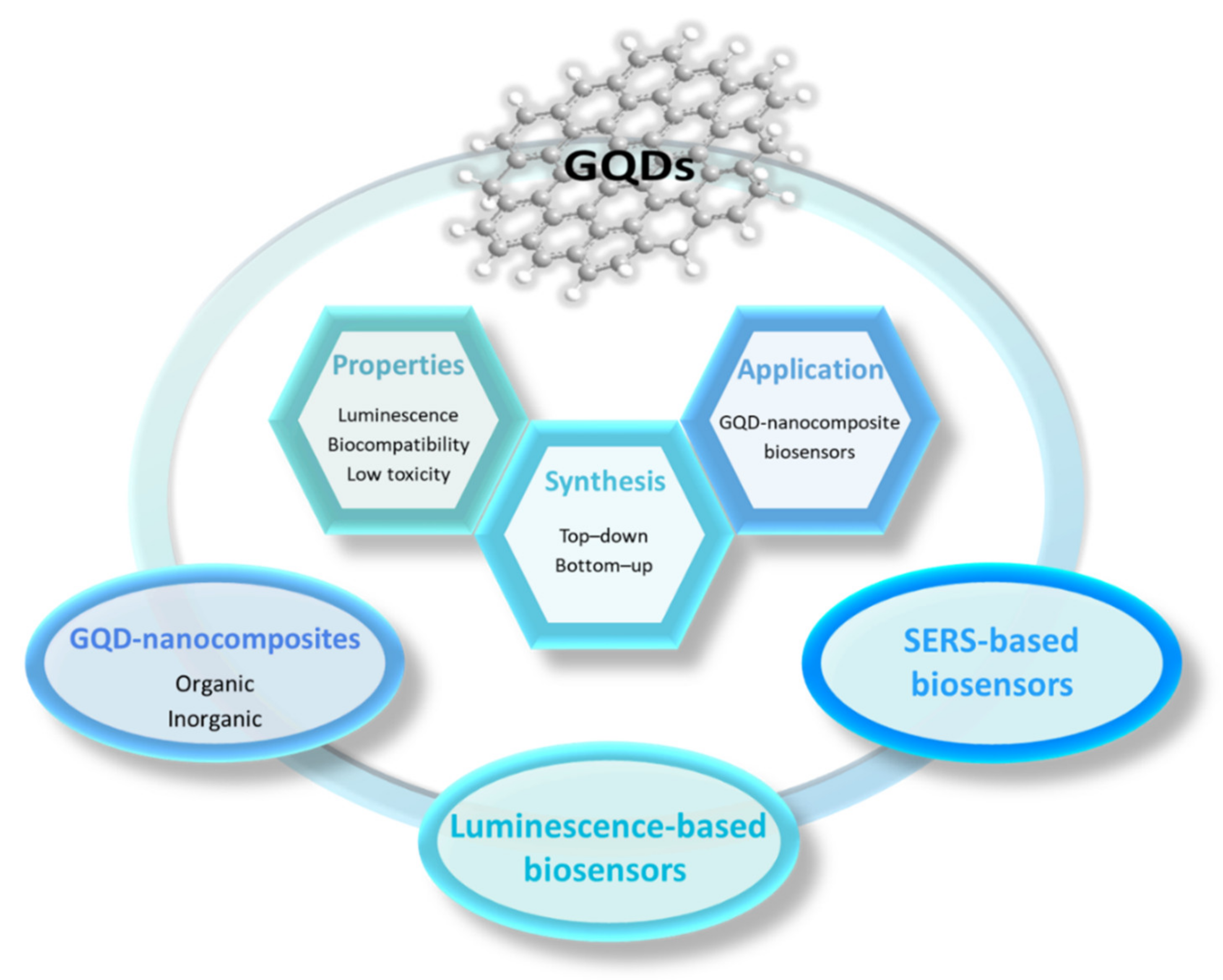
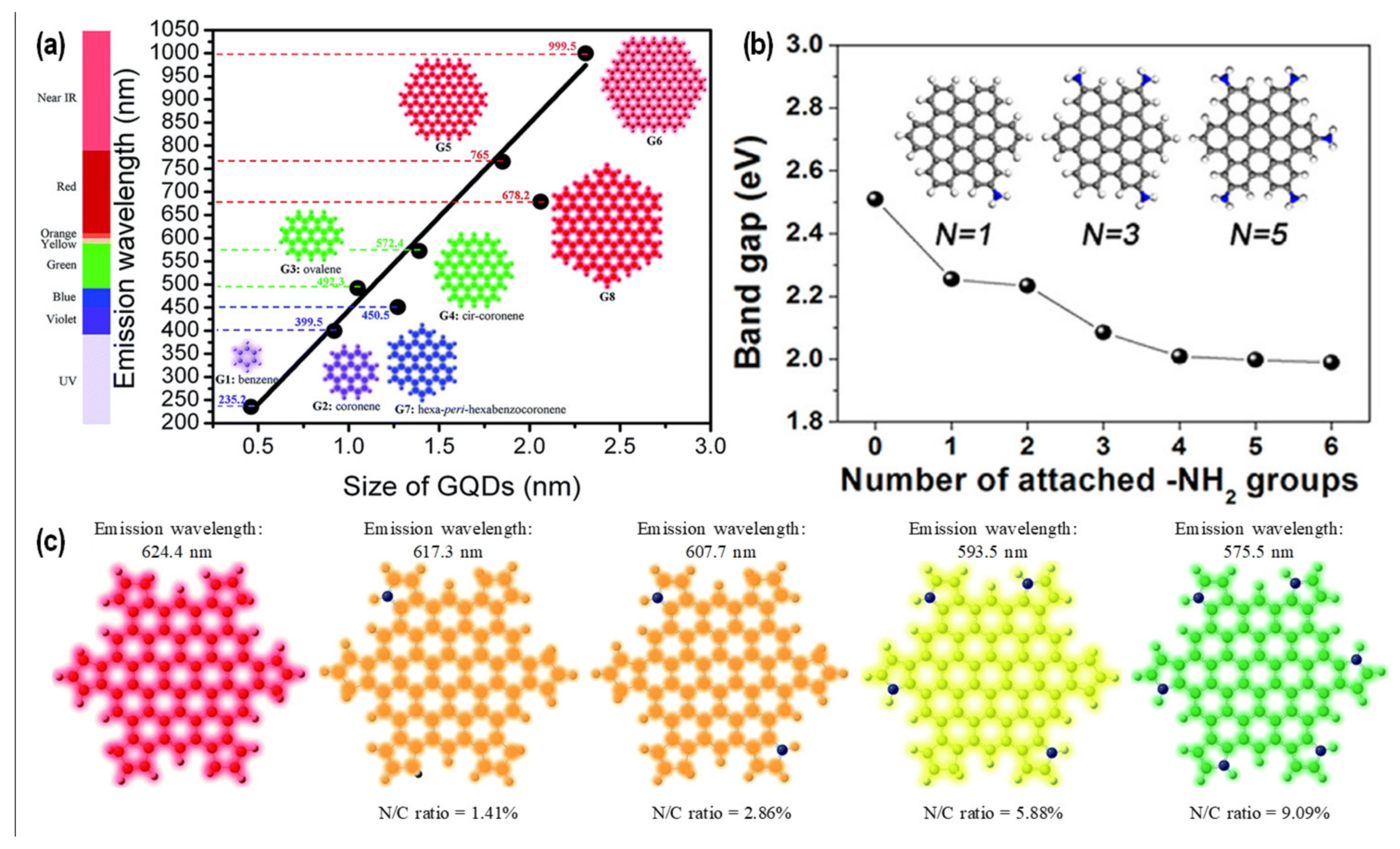
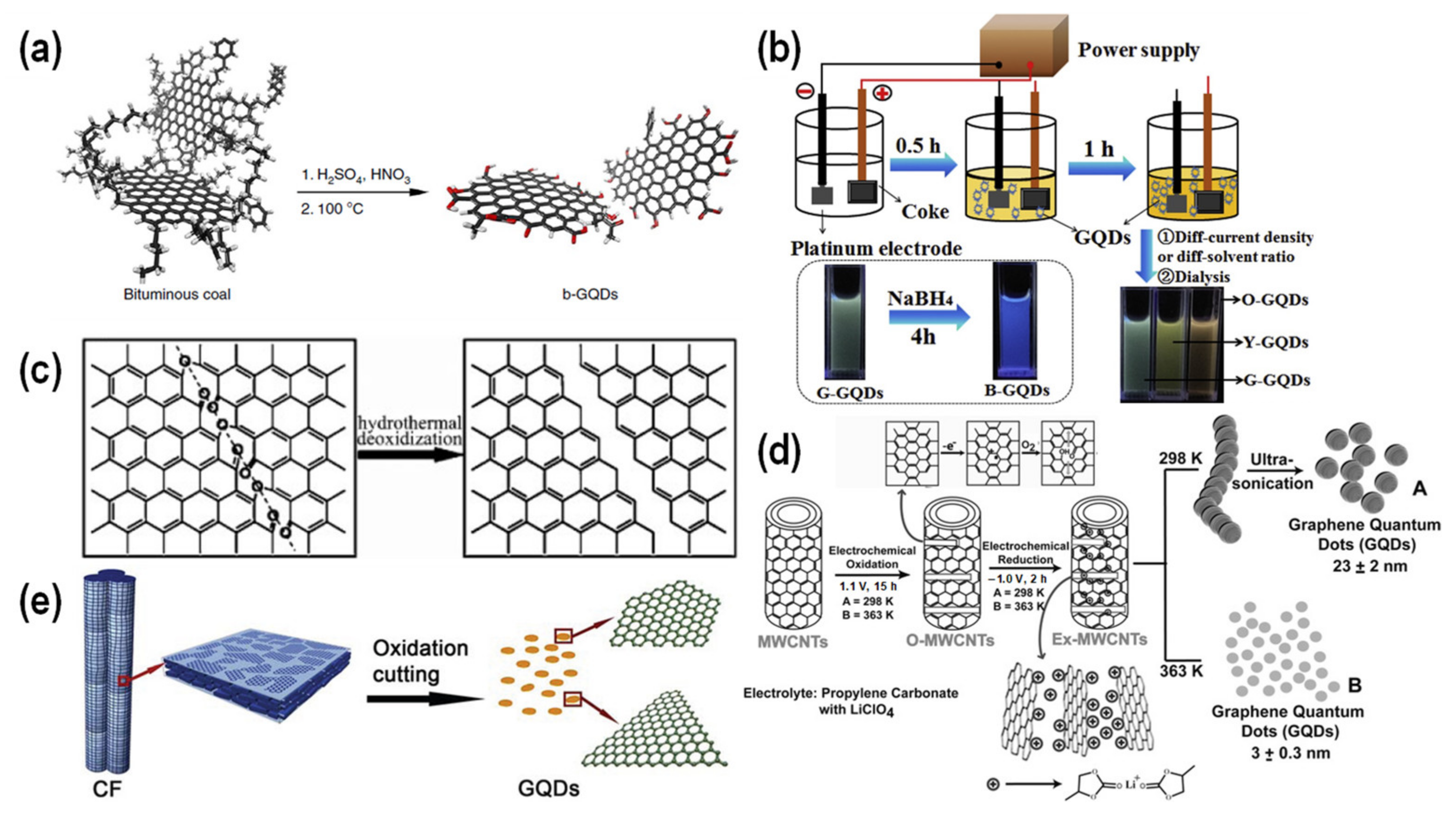
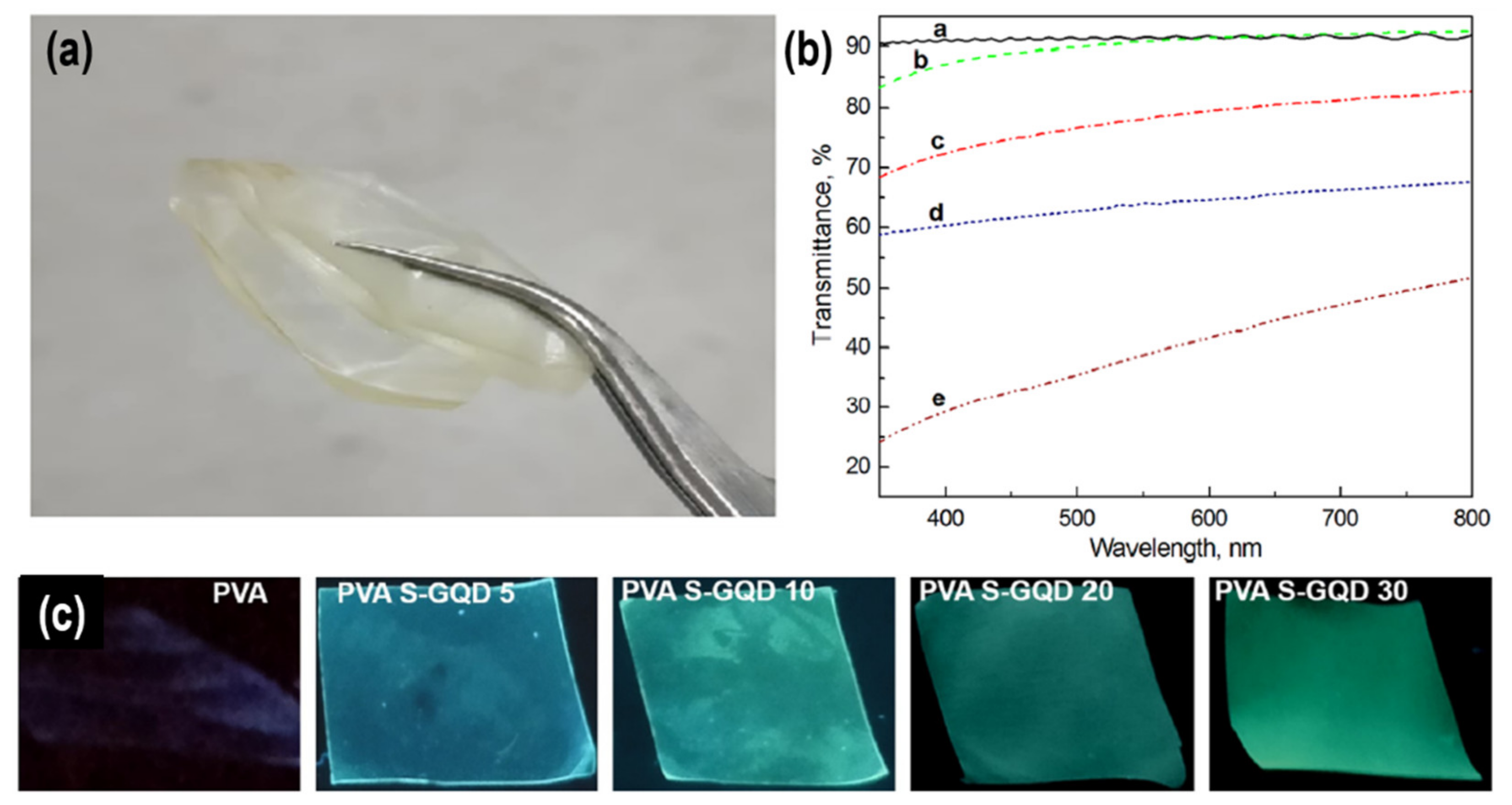
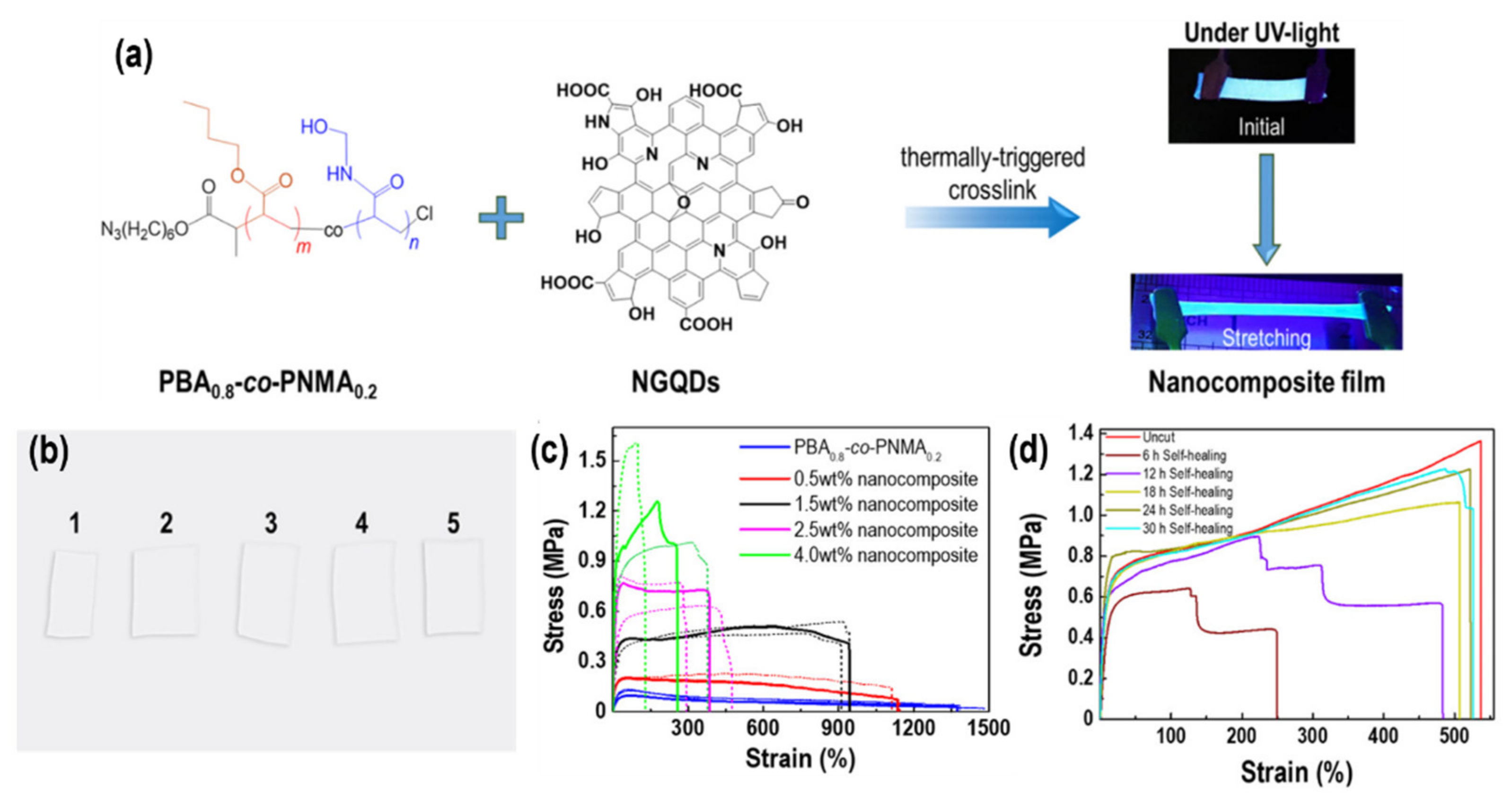

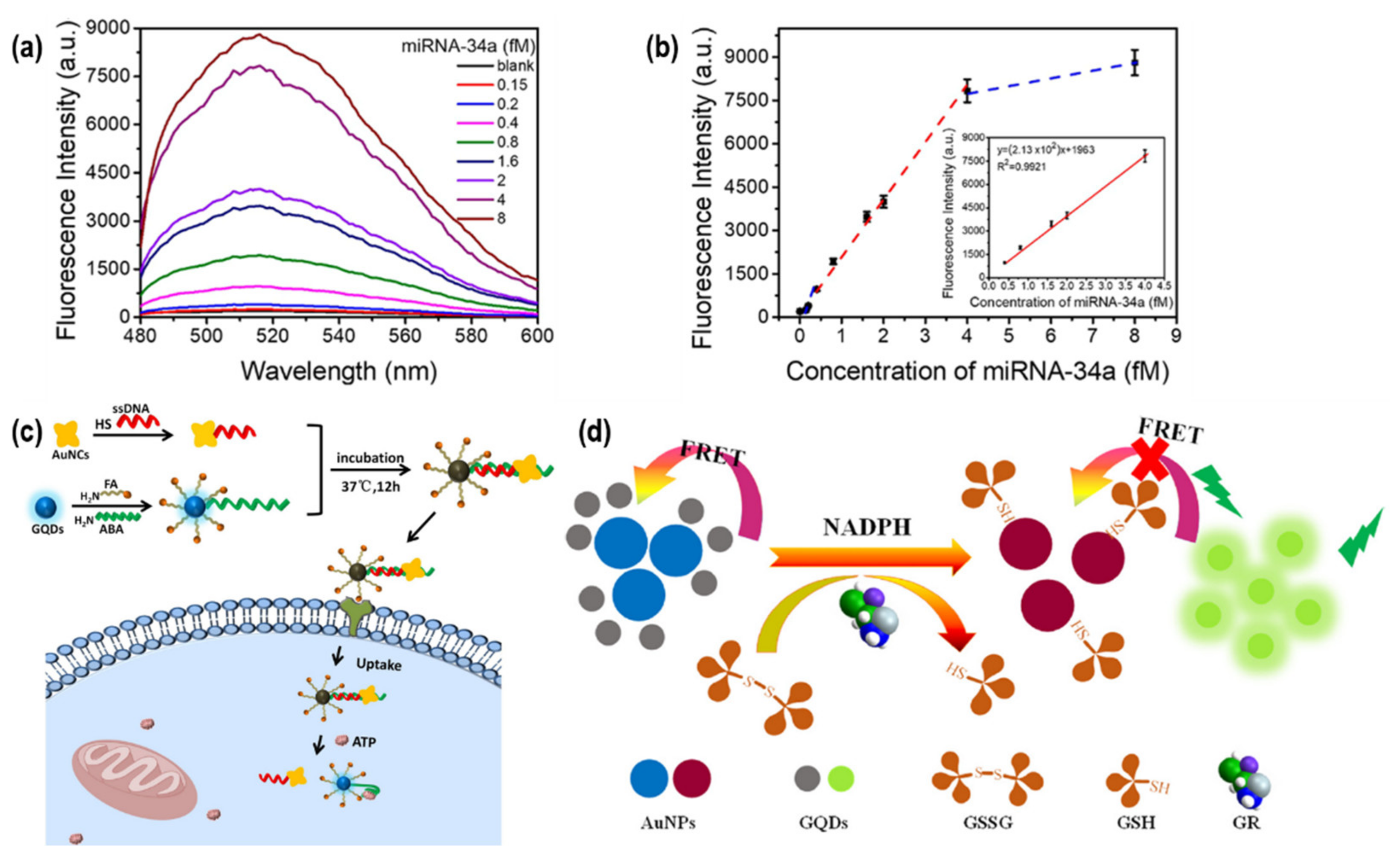
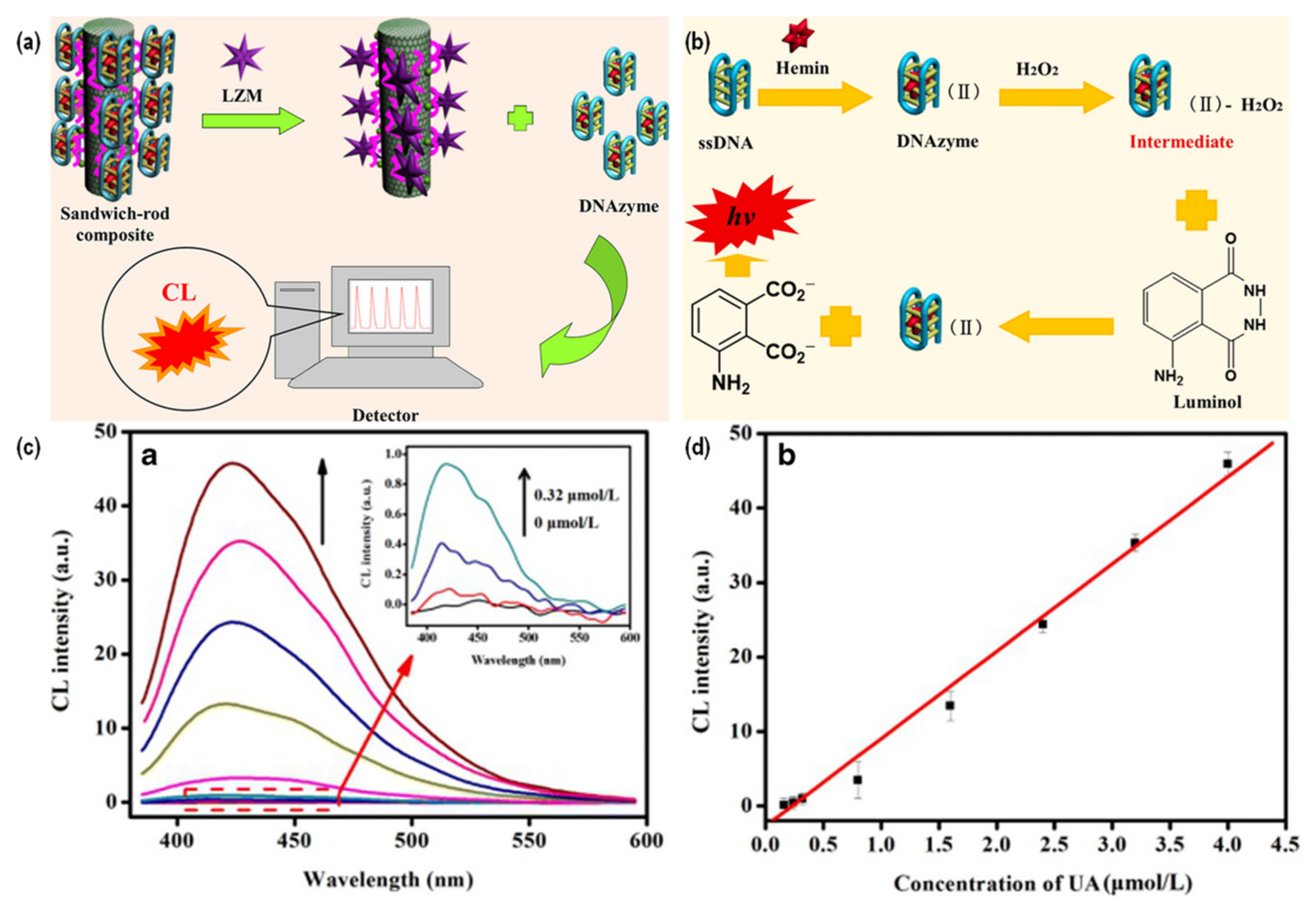
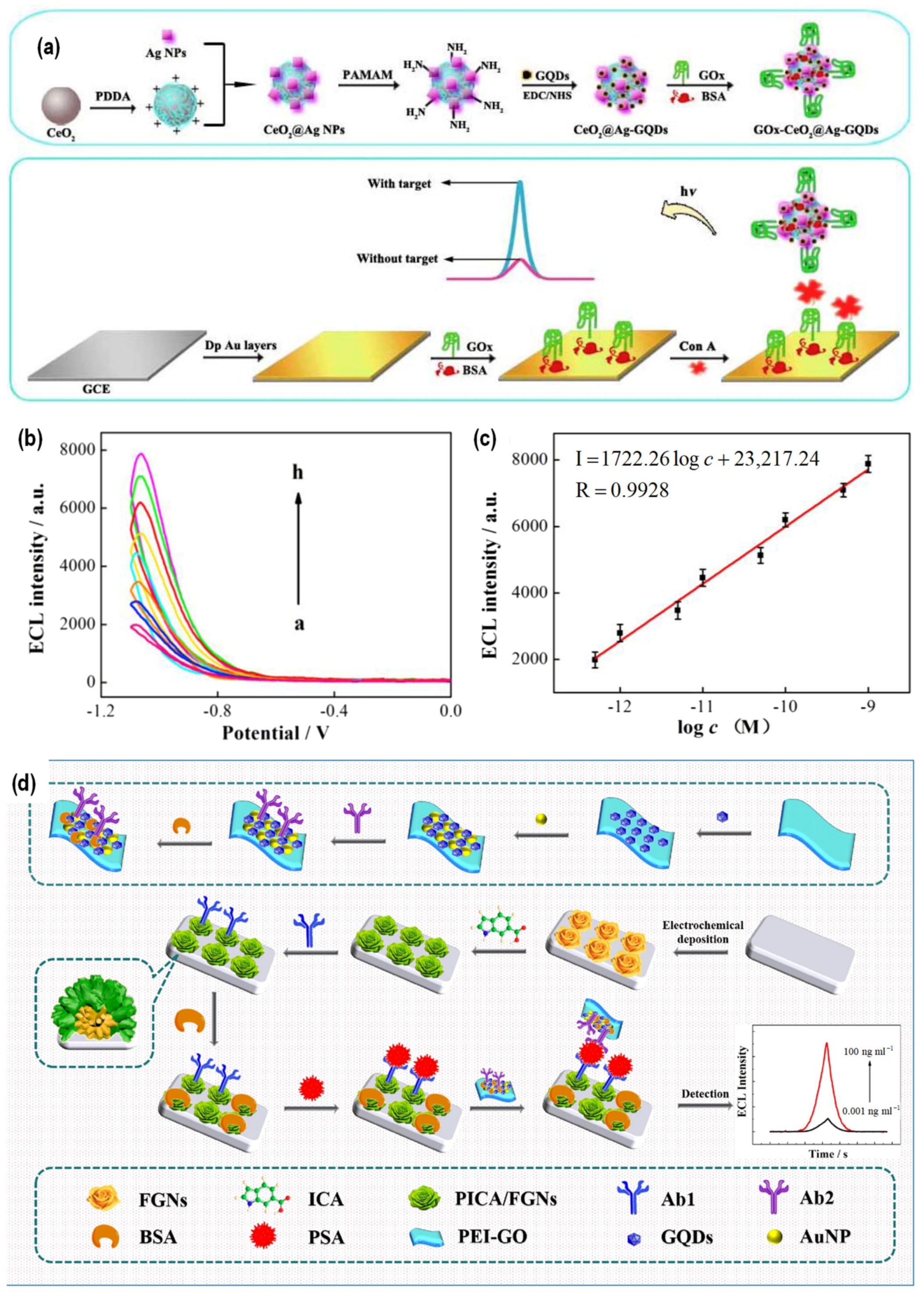

| No. | Precursors | Synthesis Methods | Reaction Conditions | Materials | Yield (%) | GQDs Properties | Ref. | ||
|---|---|---|---|---|---|---|---|---|---|
| Size (nm) | Emission (nm) | PLQY (%) | |||||||
| 1 | Coal | Chemical exfoliation | 24 h 100–120 °C | GQDs | 10–20 | 2.3–2.9 | 460–500 | 1.0 | [42] |
| 2 | Coke | Electrochemical exfoliation | 1 h 40 mA cm−2 | o-GQDs | 31.1 | 4.6 | 560 | 9.2 | [44] |
| 1 h 120 mA cm−2 | y-GQDs | 42.9 | 4.2 | 530 | 7.9 | ||||
| 1 h 240 mA cm−2 | g-GQDs | 17.9 | 3.0 | 500 | 8.5 | ||||
| Reduction of G-GQDs with NaBH4 | 4 h | b-GQDs | 13.0 | 2.9 | 440 | 19.3 | |||
| 3 | Graphene | Hydrothermal | 10 h 200 °C | GQDs | 22 | 9.6 | 430 | 6.9 | [6] |
| 4 | MWCNT | Two-steps electrochemical | 17 h 1 V; 90 °C | GQDs | 30–38 | 3.0 | 455 | 6.3 | [46] |
| 13 h 1 V; 90 °C | GQDs | 5.2 | 425 | 5.9 | |||||
| 9 h 1 V; 90 °C | GQDs | 8.2 | 400 | 5.4 | |||||
| 17 h 1 V; 30 °C | GQDs | 23.0 | 385 | 5.1 | |||||
| 5 | CF | Chemical exfoliation | 24 h 120 °C | GQDs | n.a. | 3.0 | 434 | n.a. | [48] |
| 24 h 100 °C | GQDs | n.a. | 6.0 | 500 | n.a. | ||||
| 24 h 80 °C | GQDs | n.a. | 9.0 | 564 | n.a. | ||||
| 6 | Trinitropyrene in NaOH | Hydrothermal | 10 h 200 °C | b-GQDs | 45 | 2.6 | 450 | 21 | [49] |
| Trinitropyrene in hydrazine and ammonia | c-GQDs | 56 | 2.9 | 475 | 45 | ||||
| Trinitropyrene in NaOH | 1 h 200 °C | g-GQDs | 63 | 3.5 | n.a. | 23 | |||
| Trinitropyrene in ammonia | 10 h 200 °C | y-GQDs | 60 | 3.8 | 535 | 7 | |||
| 7 | Trinitropyrene, thiourea, DMF, NaOH | Hydrothermal | 10 h 200 °C | N, S-GQDs | 87.8 | 2.1 | 450 | 23.2 | [50] |
| 8 | Citric acid | Pyrolysis | 30 min 200 °C | GQDs | n.a. | 15 | 460 | 9 | [52] |
| 9 | Glucose | Microwave-assisted hydrothermal | 5 min 595 W | GQDs | n.a. | 3.4 | 473 | 11 | [53] |
| 10 | Lignin | Oxidized cleavage + hydrothermal | 12 + 12 h 180 °C | NGQDs | 21 | 3.7 | 410 | 21 | [54] |
| 12 + 1 h 180 °C | n.a. | 4.4 | 430 | n.a. | |||||
| 11 | Chitosan | CVD | 3 min 250–300 °C | NGQDs | n.a. | 10–15 | 448 | n.a. | [55] |
| 12 | Chitosan | Microplasma | 1 h 9.6 mA | NGQDs | 50 | 6.4 | 532 | 30 | [57] |
| 13 | Fructose | Microplasma | 1 h 9.6 mA | GQDs | 16.6 | 4.5 | 446 | 0.9 | [69] |
| Citric acid | NGQDs | 28.1 | 3.6 | 516 | 2.6 | ||||
| Lignin | 1 h 5 mA | N, S-GQDs | 58.7 | 3.1 | 514 | 1.0 | |||
| Cellulose | 1 h 10 mA | GQDs | 3.0 | n.a. | 428 | 1.2 | |||
| Starch | 1 h 9.6 mA | GQDs | 50.9 | 4.1 | 558 | 27.5 | |||
| Biosensors | Analyte | Linear Range | LoD | Ref. |
|---|---|---|---|---|
| Au@NGQDs | DA | 1.0–100.0 μM | 430 nM | [86] |
| AuNF@GQDs | miRNA-34a | 0.4–4 fM | 0.1 fM | [91] |
| AuNCs-GQDs | ATP | 0.3–2.0 mM | 0.27 mM | [92] |
| GQDs-AuNPs | GR | 0.005–0.13 mU/mL | 0.005 mU/mL | [93] |
| GQDs/UiO-66 | Cholesterol | 0.04–1.60 μmol/L | 0.01 μmol/L | [94] |
| NG/CIS/ZnS QD | Cholesterol | 0.312–5 mM | 0.222 mM | [98] |
| Amine NGQDs@AuNPs | Neuron-specific enolase (NSE) | 0.1–1000 ng/mL | 0.09 pg/mL | [99] |
| PEHA-GQD-His | miRNA-141 | 10−18–10−12 M | 4.3 × 10−19 M | [100] |
| NGQDs/CrPic | Cholesterol | 0–520 μM | 0.4 μM | [101] |
| Biosensors | Analyte | Linear Range | LoD | Ref. |
|---|---|---|---|---|
| DNAzyme/L-Apt/GQDs@GO@CF | LZM | 0.26–66 ng/L | 12.5 pg/L | [108] |
| Cu(II)/Cu2O/NGQDs | UA | 0.16–4.0 μM | 41 nM | [109] |
| GQDs/MoS2 | Cholesterol | 0.08–300 μM | 35 nM | [110] |
| NC-Fe3O4@GQDs | Dopamine | 0.25–17.5 μg/L | 0.054 μg/L | [111] |
| Biosensors | Analyte | Linear Range | LoD | Ref. |
|---|---|---|---|---|
| GOx-CeO2@Ag-GQDs | Con A | 0.0005–1.0 ng/mL | 0.16 pg/mL | [116] |
| AuNP/GQDs-PEI-GO | PSA | 0.001–100 ng/mL | 0.44 pg/mL | [114] |
| GQDs/AuNPs-ssDNA | p53 ssDNA | 25–400 nM | 13 nM | [118] |
| GQDs@AuNP | Carcinoembryonic antigen (CEA) | 0.1 pg/mL–10 ng/mL | 3.78 fg/mL | [119] |
| MoS2-GQDs | DNA | 0.1 fM–1 nM | 0.025 fM | [120] |
Publisher’s Note: MDPI stays neutral with regard to jurisdictional claims in published maps and institutional affiliations. |
© 2022 by the authors. Licensee MDPI, Basel, Switzerland. This article is an open access article distributed under the terms and conditions of the Creative Commons Attribution (CC BY) license (https://creativecommons.org/licenses/by/4.0/).
Share and Cite
Kurniawan, D.; Chen, Y.-Y.; Sharma, N.; Rahardja, M.R.; Chiang, W.-H. Graphene Quantum Dot-Enabled Nanocomposites as Luminescence- and Surface-Enhanced Raman Scattering Biosensors. Chemosensors 2022, 10, 498. https://doi.org/10.3390/chemosensors10120498
Kurniawan D, Chen Y-Y, Sharma N, Rahardja MR, Chiang W-H. Graphene Quantum Dot-Enabled Nanocomposites as Luminescence- and Surface-Enhanced Raman Scattering Biosensors. Chemosensors. 2022; 10(12):498. https://doi.org/10.3390/chemosensors10120498
Chicago/Turabian StyleKurniawan, Darwin, Yan-Yi Chen, Neha Sharma, Michael Ryan Rahardja, and Wei-Hung Chiang. 2022. "Graphene Quantum Dot-Enabled Nanocomposites as Luminescence- and Surface-Enhanced Raman Scattering Biosensors" Chemosensors 10, no. 12: 498. https://doi.org/10.3390/chemosensors10120498
APA StyleKurniawan, D., Chen, Y.-Y., Sharma, N., Rahardja, M. R., & Chiang, W.-H. (2022). Graphene Quantum Dot-Enabled Nanocomposites as Luminescence- and Surface-Enhanced Raman Scattering Biosensors. Chemosensors, 10(12), 498. https://doi.org/10.3390/chemosensors10120498








